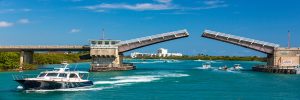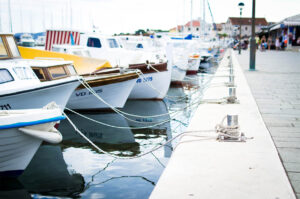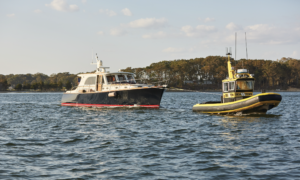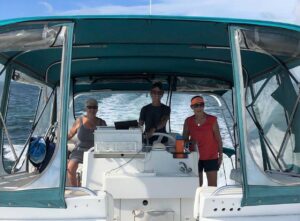About 17 million recreational boats are in use in the United States, according to the latest figures from the National Marine Manufacturers Association. I don’t know about you, but it seems like most of those boats are crossing in front of ours on summer weekends. The waterways are busy and are about to get busier with the pandemic-fueled growth in recreational boating since these figures were compiled.

According to the most recent data published by the U. S. Coast Guard in 2019, 4,168 boating accidents were reported, which sadly included 613 deaths and more than 2,000 injuries. These incidents cost a staggering $55 million in damage to property. Two leading causes of these accidents were operator inattention and improper lookout. So, how do we improve our chances of not becoming one of these statistics when going out to enjoy a day on the water?
Knowing that a large percentage of boating accidents are caused by inattention or improper lookout, one of the best ways to improve safety is to increase the number of eyes watching for danger. A boat may only have one captain, but all the eyes on board can help keep the vessel safe.
A friend joined us aboard our boat recently on a busy Saturday outing. After listening to my wife point out all the boats, crab pots and buoys in our path, he leaned over and whispered to me “Does she always do this? That would drive me crazy.” I said she sure does, and I don’t ever want her to stop. On more than one occasion she has seen a boat approaching that I hadn’t noticed, or a small floating buoy I missed. I’ll gladly listen to her observations to keep us safe.
Having friends and family join you on the water is one of the most enjoyable aspects of boat ownership; however, I have observed an inverse relationship between the number of people on board and the number of eyes looking out for danger. The more people you have on your boat, the more likely they are to be engaged with each other or the day’s activities than they are to assist with anything related to the boat.
Now, you may say this is normal: “I didn’t invite my friends to go boating to have them help me run the boat.” This may be true, but wouldn’t you like someone to notify you of a potential problem?
Whether sail or power, a lot of things could be happening on a boat at one time, especially if you enter a busy inlet or harbor. Dropping sails or coming off plane, monitoring a rising bottom and paying attention to your position in the channel, and needing to call a bridge tender or marina on the VHF radio can take your attention away from intersecting boat traffic or hazards in your path. Having another set of eyes to assist could be the difference between arriving safely or being towed in with the marine police following you.
The tradition of watch keeping aboard a ship has existed as long as floating vessels have gone to sea. It’s the act of assigning specific roles and times to personnel on board to keep the vessel safe — from collision, fire or any potential hazard that could arise. Most recreational boaters take too relaxed a view of this.

The best plan is to have a dedicated mate to act as a lookout; one that is willing to join the party once the boat is safely anchored or tied to the dock. Or conversely, have a mate tend to guests while you focus on driving the boat. I give our guests the same speech each time we go out, “Please forgive me if I don’t pay much attention to you while we’re underway. The waterway will be busy today, so I’m going to pay attention to the boat. If you see, hear or smell anything on board or around us that doesn’t seem right, please don’t hesitate to let me know. Now, sit back and enjoy the ride.”
Danger doesn’t always come in the form of other boats. I remember an occasion when an attentive guest’s observation paid off. While sitting in the back of a fishing boat near the engine cowling, the guest heard a whine get louder and louder. Calling attention to it helped the captain catch an alternator bearing that was failing, which could have had serious consequences or even caught fire had it seized completely.
Not all boating requires the same level of attentiveness. Cruising along the coast in the ocean is very different from traveling along the busy Intracoastal Waterway (ICW). With the assistance of autopilot, radar tracking and Automatic Identification System (AIS), it is much easier to keep track of fewer boats around you in the ocean. But a vigilant lookout is important. It is amazing the number of close calls that occur between boats in open water.
In all boating situations, understand the rules of the road and know who has the right of way — but don’t assume other boaters do. Avoid playing chicken or challenging another boater over right-of-way. If you spot a boat at a distance on an intersecting course, follow rules of being the stand on or give way vessel, up until a point of realizing the other boat is not following the rules. Take early and obvious measures to avoid the other boat. I’ve maneuvered around boats in the ocean, only to see no one at the other boat’s helm as we pass.
On longer runs, captains may have to turn over the helm to a mate for a break. In doing so, make sure you communicate everything you know when handing over the helm. Don’t assume the person taking over sees the navigation aids ahead. If in the ICW, remind them what side the reds are on for this stretch of water. Alert them to any other vessels you’re tracking. If you made an adjustment to your speed to conduct a safe passing arrangement with another boat, it could be dangerous for them to take over the helm and ask themselves “Why are we going so slowly?” and resume a normal cruising speed.
When most boaters free their lines and head for open water, they do so in a mild state of denial, an innocent but dangerous unwillingness to admit something could go wrong. Staying safe is more than just having the proper safety equipment aboard your boat, it is a state of mind to make the conscious effort to act in a safe manner, keep a look out for trouble and be unwilling to become a boating accident statistic.





